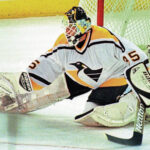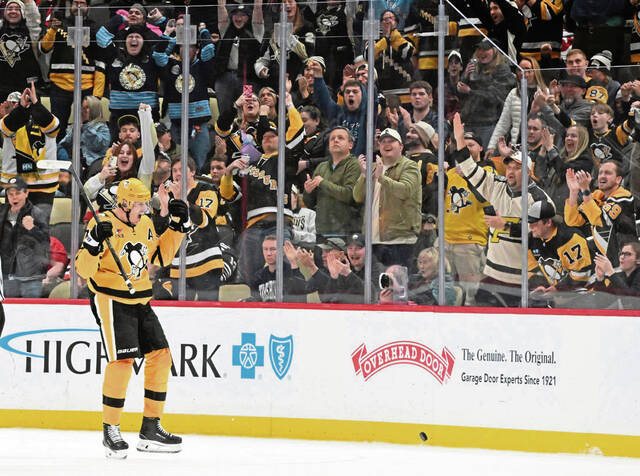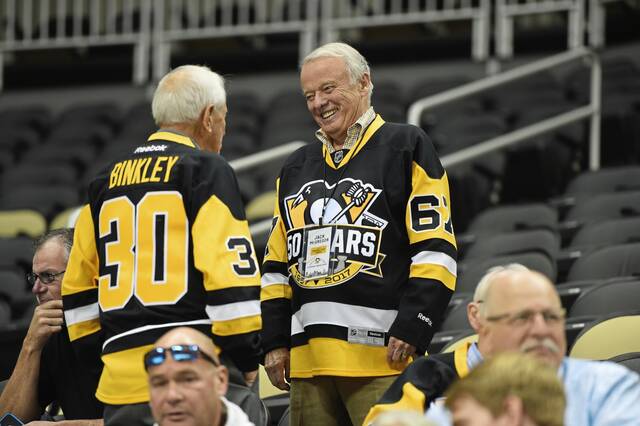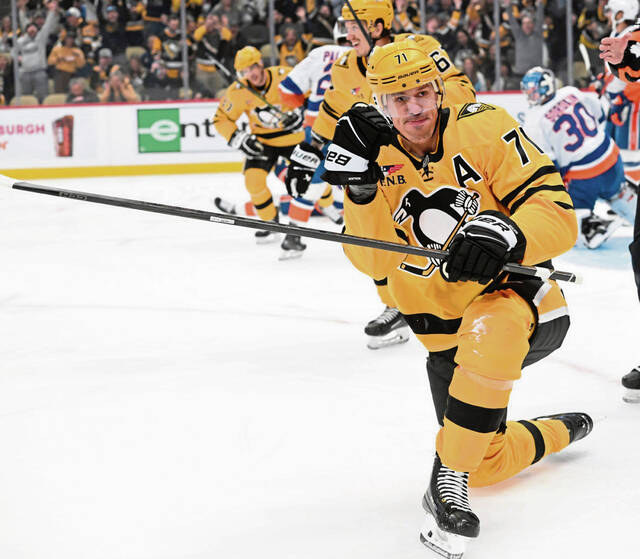Tom Barrasso was a star well before he arrived in Pittsburgh.
A phenom who was drafted out of high school and joined the Buffalo Sabres as an 18-year-old in 1983, he became one of only three players in NHL history to win the Calder Memorial Trophy as top rookie and the Vezina Trophy as top goaltender in the same season.
And when he joined the Penguins via a trade in November of 1988, it was something of a slightly odd marriage.
He was a goaltender who was used to posting strong numbers while largely carrying the underwhelming Sabres. And now, he was a member of the Penguins, who typically treated defense as if it were jury duty.
But Barrasso ultimately fit perfectly with the Penguins and became one of the more important figures in the history of the franchise, helping lead it to its first Stanley Cup championships in 1991 and 1992.
“Here’s a guy that won the Vezina and the Calder as an 18-year-old,” former Penguins forward Phil Bourque said. “So you take a lot of pride in what your numbers are when you have that sitting on your mantelpiece. Something happened when he came here to Pittsburgh where he stopped giving a (expletive) about his goals-against (average) and his save percentage. He just figured out that winning is more important than any of that other stuff.”
All of those wins (and the other stuff, as well), led to Barrasso being selected for induction into the Hockey Hall of Fame this fall.
The hall announced its class of 2023 on Wednesday.
Barrasso, who last played in the NHL during the 2002-03 season, had been eligible since 2006.
“I was definitely not waiting by the phone,” Barrasso quipped during a conference call with media after the announcement. “In fact, (hall executives) had a hard time getting ahold of me even after they made the decision.”
The decision by then-general manager Tony Esposito to add Barrasso to the Penguins’ nest in 1988 had considerable ramifications on a franchise that never won in any substantial fashion to that point, even after the arrival of franchise savior Mario Lemieux in 1984.
“He goes from Buffalo where he was expected to kind of carry the franchise … to our team where we had this other guy that played on our team that played on our team that was pretty good about carrying the team,” quipped former Penguins forward Troy Loney. That took some pressure off of Tom.”
Before Barrasso arrived, the Penguins saw a revolving door of journeymen goaltenders — Les Binkley, Al Smith, Denis Herron, Jim Rutherford, Gary Inness, Dunc Wilson, Herron again, Greg Millen, Michel Dion, Herron yet again, Roberto Romano and Gilles Meloche — generate limited success.
After Barrasso arrived, the Penguins qualified for the playoffs for the first time in seven years. Two years after that, they won the Stanley Cup for the first time.
“You don’t win without great goaltending,” said former Penguins forward Bryan Trottier, a six-time Stanley Cup champion as a player. “You need great goaltending. You need them to make the big saves. You need them to be the guy.
“Tommy was that guy.”
Before the arrival and ascension of Marc-Andre Fleury in the 2000s, Barrasso was the Penguins’ guy in the record book and held virtually every franchise mark of note for goaltenders.
In 460 games over parts of 12 seasons with the Penguins, Barrasso had a 226-153-53 record, a 3.27 GAA, a .895 save percentage and 22 shutouts. He still holds the franchise mark for goaltending wins in a season, having gone 43-14-5 during the 1992-93 season.
Many of those figures seem pedestrian compared to the tabulations of modern goaltenders. But Barrasso largely played in an era when offensive figures were typically inflated. And the Penguins were one of the NHL’s more prolific offensive engines during that time (albeit, at the expense of anything resembling sound defense).
Barrasso’s own offensive figures reflect that as he is the NHL’s career leader in points among goaltenders with 48 (all assists).
During an era when goaltenders weren’t necessarily expected to handle the puck, Barrasso was an innovator at that aspect of the position.
“At the time, when not a lot of goalies handled the puck, stickhandled, shot the puck, Tommy was one of the best,” Trottier said by phone. “We used Tommy to counter a lot of teams in transition. They shot it in, he shot it out.
“He was better than some defensemen in moving the puck.”
In some ways, he was a defenseman.
“When that puck was being shot in, rimmed along the glass, rimmed along the kickboards, maybe it’s just fired into you … Tommy, like a defenseman, would be thinking one play or even two plays ahead,” Bourque said. “ ‘If the puck comes to me, I can pass it over here to Paul Coffey on the left side. Or if the puck comes to me, I can airmail it to center ice to Mario (Lemieux) Part of wiring was a personality that could be cantankerous, particularly with media but also teammates.
Barrasso dismissed any suggestion his surly dealings with reporters led to him waiting nearly two decades to be enshrined.
“I don’t think that’s anything that’s ever been in the back of my mind,” Barrasso said. “The media didn’t help me win games. They didn’t make me lose games. To me, it was just me showing up and doing my job. I tried not to ever be too conscious of that.
“I don’t particularly have any real regret with much of that. There’s people out there that are not pulling for you sometimes, and that’s the way it goes. So you don’t need to be cozy with them. The people you need on your side are your teammates and your family. That’s what gets you through.”
His teammates from those halcyon days with the Penguins remain by his side.
“Tommy can be misread at times, if he’s a little short or if he’s a little bit edgy,” said Trottier, who inhabited a locker stall next to Barrasso at Civic Arena. “But I always say goaltenders in general … can be a breed of their own.”
Barrasso could be direct with teammmates.
“Always treated me well,” Loney said. “Very respectful. But you were always going to get an opinion from him and that’s just the way he rolled.
Barrasso, 58, is said to have mellowed a bit in recent years.
“I’ve seen Tommy do some autograph signings in Pittsburgh,” Bourque said. “And I’ve just heard more complimentary things about him just in the last two years than in the previous 20 years.”
In addition to the Penguins and Sabres, Barrasso played for the Ottawa Senators, Carolina Hurricanes, Toronto Maple Leafs and St. Louis Blues. A native of Boston, Barrasso appeared in 777 career games and had a 369-277-86 record, 3.24 GAA and 38 shutouts. His win total is the third-highest in NHL history among right-catching goaltenders, something of a rarity in the sport. Only Esposito (426) and Grant Fuhr (403) have more career victories among starboard goaltenders.
“I’m very comfortable with my career, all of it,” Barrasso said. “I can live with that. There’s good in it. There’s bad in it. That’s life. I’m quite comfortable with it.”
Barrasso currently is a coach with Asiago, an Italian team that competes in the International Central European Hockey League, primarily based in Austria. He is joined by goaltenders Henrik Lundqvist, Mike Vernon, forward Pierre Turgeon, coach Ken Hitchcock, general manager Pierre Lacroix and women’s forward Caroline Ouellette in the Hockey Hall of Fame’s 2023 class, which will be inducted Nov. 13.











